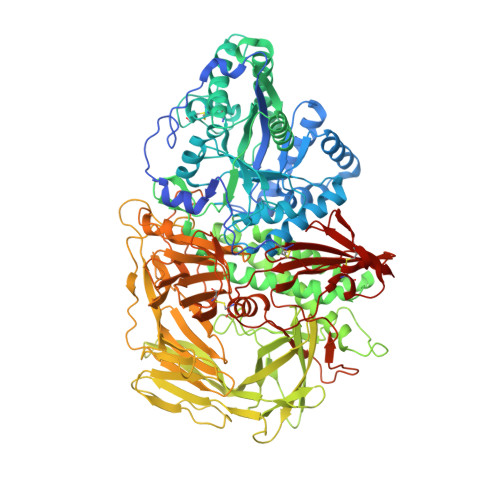Structural analysis of Golgi alpha-mannosidase II inhibitors identified from a focused glycosidase inhibitor screen.
Kuntz, D.A., Tarling, C.A., Withers, S.G., Rose, D.R.(2008) Biochemistry 47: 10058-10068
- PubMed: 18759458
- DOI: https://doi.org/10.1021/bi8010785
- Primary Citation of Related Structures:
3D4Y, 3D4Z, 3D50, 3D51, 3D52 - PubMed Abstract:
The N-glycosylation pathway is a target for pharmaceutical intervention in a number of pathological conditions including cancer. Golgi alpha-mannosidase II (GMII) is the final glycoside hydrolase in the pathway and has been the target for a number of synthetic efforts aimed at providing more selective and effective inhibitors. Drosophila GMII (dGMII) has been extensively studied due to the ease of obtaining high resolution structural data, allowing the observation of substrate distortion upon binding and after formation of a trapped covalent reaction intermediate. However, attempts to find new inhibitor leads by high-throughput screening of large commercial libraries or through in silico docking were unsuccessful. In this paper we provide a kinetic and structural analysis of five inhibitors derived from a small glycosidase-focused library. Surprisingly, four of these were known inhibitors of beta-glucosidases. X-ray crystallographic analysis of the dGMII:inhibitor complexes highlights the ability of the zinc-containing GMII active site to deform compounds, even ones designed as conformationally restricted transition-state mimics of beta-glucosidases, into binding entities that have inhibitory activity. Although these deformed conformations do not appear to be on the expected conformational itinerary of the enzyme, and are thus not transition-state mimics of GMII, they allow positioning of the three vicinal hydroxyls of the bound gluco-inhibitors into similar locations to those found with mannose-containing substrates, underlining the importance of these hydrogen bonds for binding. Further, these studies show the utility of targeting the acid-base catalyst using appropriately positioned positively charged nitrogen atoms, as well as the challenges associated with aglycon substitutions.
Organizational Affiliation:
Ontario Cancer Institute, Canada.

















